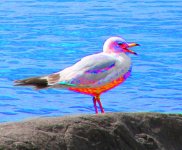With all due respect, may I assume that you have little or no experience with recreational photo retouching? I do, and let me assure you, just the tone and appearance of the water is a dead giveaway. If go to the creator's gallery at
digiart, you will see that he or she has been experimenting with flares of color in selected areas for artistic effect in multiple ways, sometimes against sepia, and sometimes against more natural tones.
Did they add fluorescent blue paint to the water behind the gull,too? Did the gull wade through radioactive red paint to give its legs that color? How about the patterns of pink dots on the wing coverts, and the way the feather edges and chevrons are carefully traced in fluorescent green? Fascinating "natural" effects, and how the splattering of the chemicals randomly happened to exactly trace selected plumage patterns, eh?






